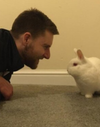The Independent Podcaster Report 2025: Inside the Minds of 558 Creators
The 2025 Indiepod Survey reveals how 558 indie podcasters balance passion, growth struggles, and monetisation. Discover key trends in audience, goals, and the future of podcasting.
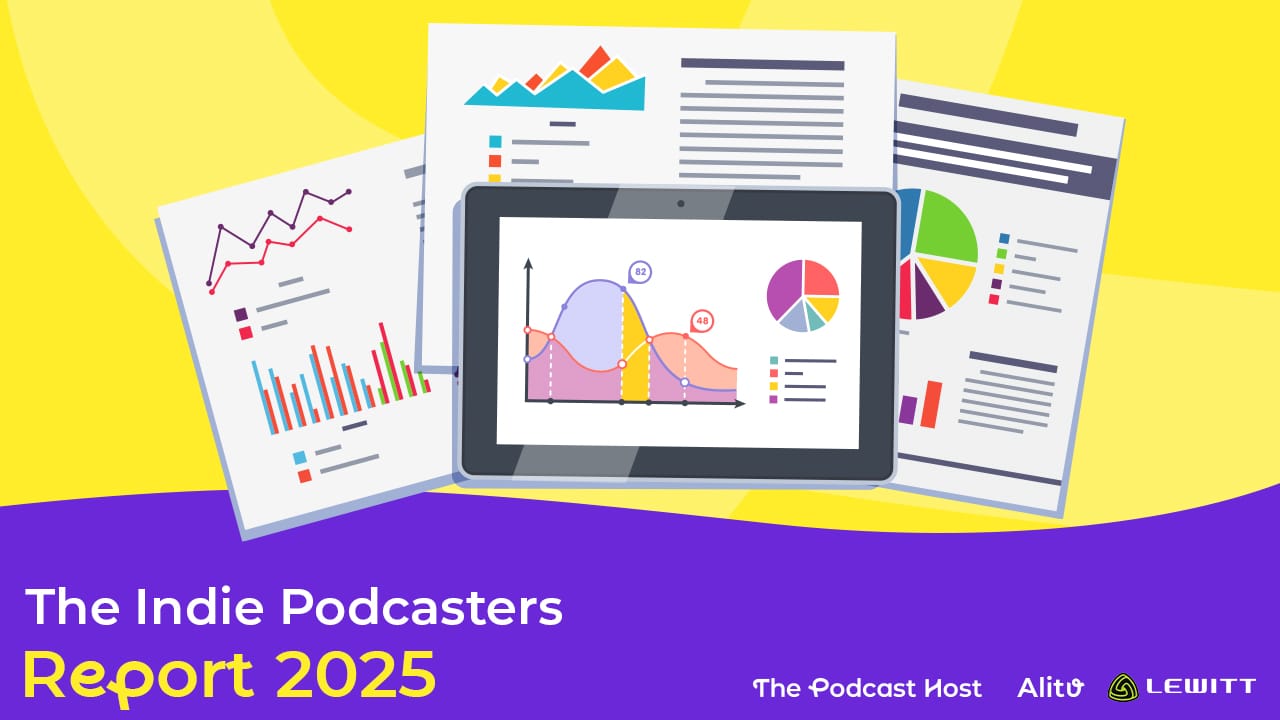
The 2025 Indiepod Survey collected insights from 558 independent creators. The goal was to understand the real state of indie podcasting and what it takes to build and sustain a show today.
We asked creators about the core challenges they face, how they make money, and how they are using video and AI. We also examined how long it takes to produce an episode, and what podcasters spend each month to keep their shows running.
Beyond the practical process, we explored how podcasters define success, what they worry about for the future, where they seek support, and what drives them forward. We also asked a tough but important question about the moments when they have considered quitting.
We wanted to get this data out and into your hands as soon as possible, so you can explore the results, spot the trends that catch your eye, and share your own perspectives on what they mean.
We’ll also share key patterns and stories that emerged from the data. For more detailed analysis on each topic, visit Podcraft Perspectives, where we’re publishing focused follow-ups to this report.
Our Methodology
We invited independent podcasters to participate in the survey through our own channels. This included Podcraft Pointers (our newsletter of 29,000+ podcaster subscribers), The Podcast Host blog, the Podcraft podcast, and an in-app message for active creators using our podcast creator software, Alitu.
We also partnered with friends and organisations in the podcasting industry who shared the survey with their audiences. This multi-channel approach helped us reach a broad and engaged sample of active independent podcasters.
We know podcasters’ time is valuable, so the survey took only a few minutes to complete. To show our appreciation and incentivise participation, we partnered with audio company LEWITT to offer gear in a prize draw, and we sent a free PDF copy of our Podcast Growth book to every respondent who shared an email address.
Limitations
Like any survey, these results represent a sample rather than the entire podcasting community. Our respondent pool largely reflects the makeup of our own audience, which may not capture the full range of backgrounds, experiences, and perspectives across podcasting. We share this report as a snapshot of the podcasters we reached and remain committed to broadening participation and learning more in future surveys.
Who Took the 2025 Indiepod Survey?
We had a total of 558 respondents, but who are they? This demographic data helps build a picture of our sample.
Age
Almost half of our respondents were over 50. In fact, nearly three-quarters were over 40, suggesting that older adults may be more likely to respond to surveys like this. This skews the overall perspective slightly, but it also gives a rare look at an audience that is often overlooked in podcasting research.

- 18-30 – 7%
- 31-40 – 17%
- 41-50 – 25%
- 50+ – 47%
- Prefer not to say – 4%
While responses from Millennial and Gen Z creators were limited, the sample divides fairly evenly between under-50s and over-50s.
Among the over-50 group, 21% had yet to launch a show, compared with 17% of under-50s. We'll return to other age-related findings in the sections on quitting and the biggest threats to podcasters.
Gender
We saw a reasonably even split of responses from female and male creators.
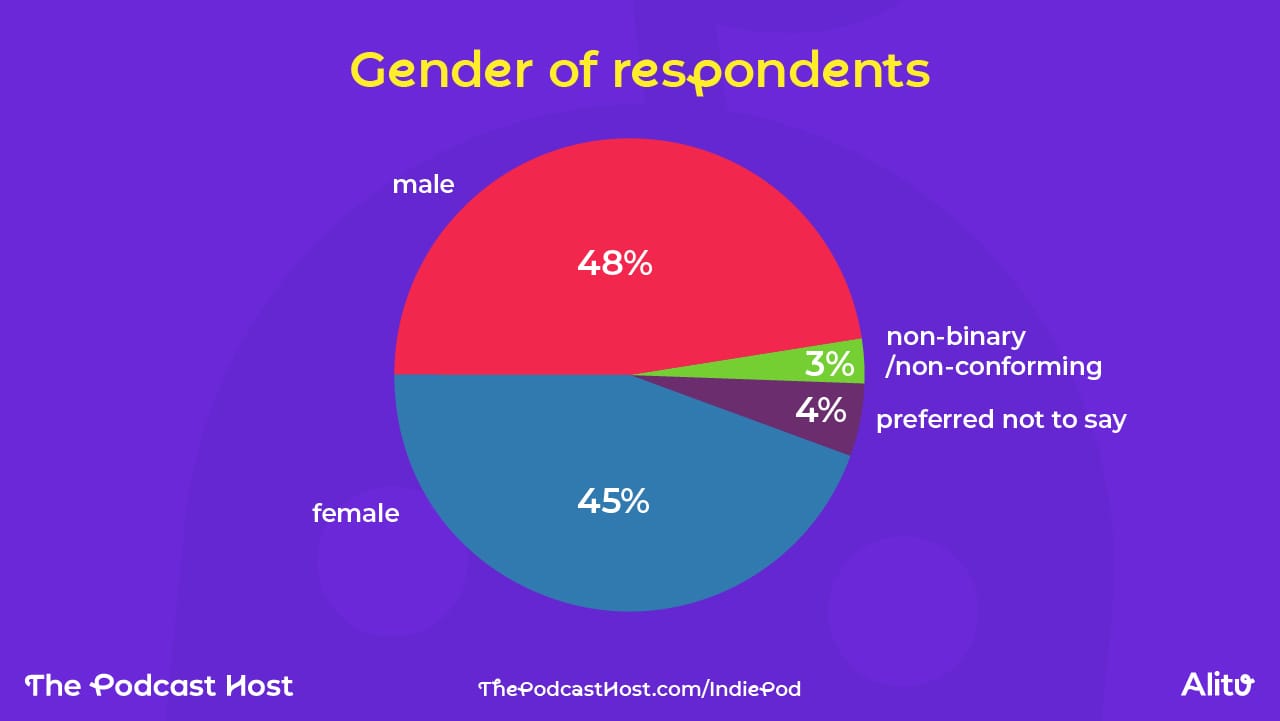
- 48% were male
- 45% were female
- 3% were non-binary/non-conforming
- 4% preferred not to say
13% of the men were yet to launch, whilst 24% of the women were at the pre-start stage. We'll dig into a few notable gender differences later, focusing on goals, challenges, and barriers.
Ethnicity
In terms of ethnicity, 68% of respondents identified as white, with the rest spread across a range of backgrounds

- 68% were White/Caucasian
- 11% were Black or African American
- 7% preferred not to say
- 5% were Hispanic or Latino
- 5% said they have multiple ethnicities
- 3% were Asian/Pacific Islander
- 1% were American Indian or Alaskan Native
Podcasting experience
Next, we asked respondents how long they've been getting behind the mic.

- 19% are yet to launch their podcast
- 25% have been podcasting less than a year
- 19% have been podcasting 1-3 years
- 15% have been podcasting 3-5 years
- 14% have been podcasting 5-10 years
- 8% have been podcasting more than 10 years
It was brilliant to hear from so many pre-launch podcasters. Their data helps give us a hint of what’s on the minds and to-do lists of aspiring creators.
It's worth mentioning that we excluded these pre-launchers' answers to most survey questions since they weren't able to tell us about their experiences running their show yet. We’ll let you know where this is the case in the data descriptions.
Alright, now that we know the "who", let's crack on with the "what"...
What’s the ultimate goal of your podcast?
There’s a purpose behind every podcast, and we wanted to dig into those creator motivations.

I think most podcasters would identify with more than one goal in this list, but we aimed to uncover the one that truly fuels them.
The primary goal for just under a third of respondents was to "help, support, or motivate others".
- Help, support, or motivate others – 31%
- Personal enjoyment/creative outlet – 20%
- Raise awareness about a cause or topic – 12%
- Establish a main income source – 11%
- Develop or promote a business/brand – 10%
- Build my authority on a topic – 8%
- Create a side hustle – 4%
- Learn or achieve personal growth – 3%
- Other – 2%
When we dug into the gender split, "help, support, or motivate others" was the most popular answer among female respondents (38%), followed by "personal enjoyment" at 15%.
25% of Male respondents chose "help, support, or motivate others", and another 25% reported "personal enjoyment" as their ultimate goal,
We asked this question in our 2022 survey (although we used the word 'motivation' rather than 'goal'). In the previous report, “to help, support, and motivate” was the most popular response, too.
Personal enjoyment and creative outlet were also big motivating factors, which aligned with our 2022 data.
What are your biggest challenges as a podcaster?
For this question, we excluded our pre-launch podcasters, since their challenges are more short-term. Our focus was on the recurring hurdles faced by active creators.
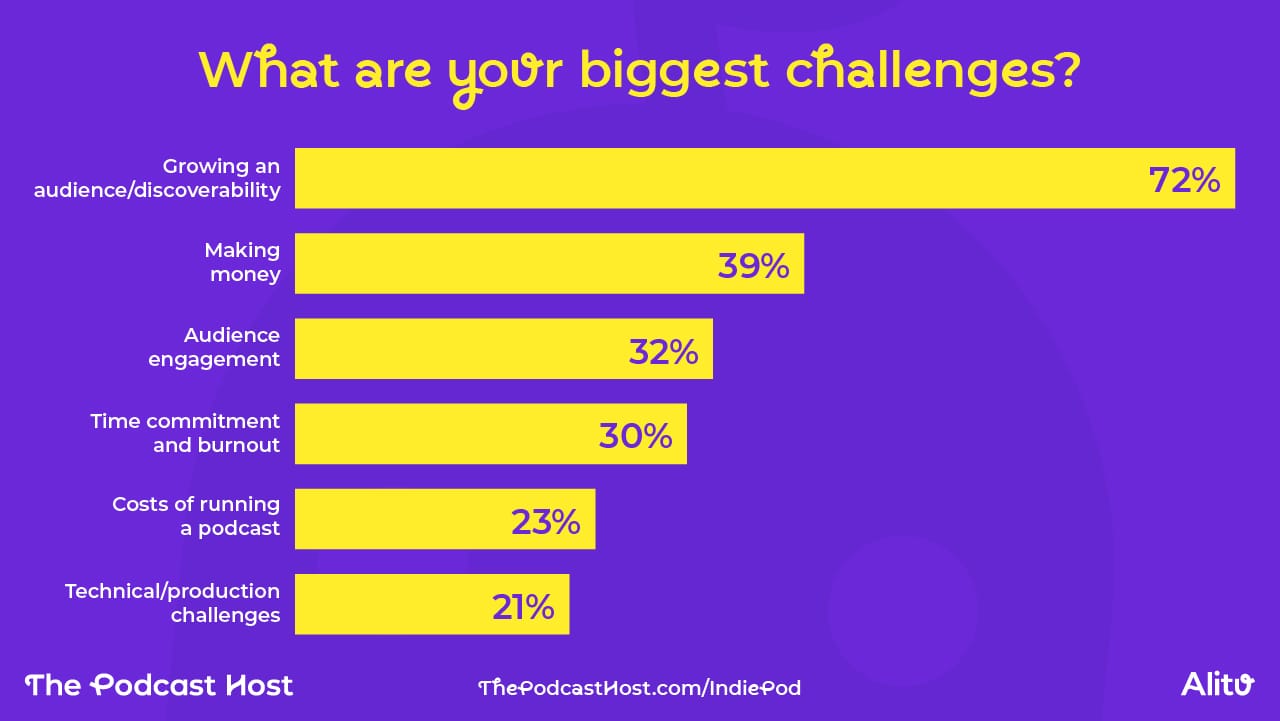
- Growing an audience/discoverability – 72%
- Making money – 39%
- Audience engagement – 32%
- Time commitment and burnout – 30%
- Costs of running a podcast – 23%
- Technical/production challenges – 21%
- Finding guests – 7%
- Other – 2%
Respondents were allowed to pick more than one answer. Unsurprisingly, the key focus was on audience growth and discoverability.
Interestingly, this challenge doesn't disappear as you grow. It remains the top issue for shows with 500 or more downloads (58%), 1,000 or more downloads (56%), and even 5,000 or more downloads (47%).
49% of females saw making money as their biggest challenge, whilst this dropped to 34% amongst post-launch males.
Does your podcast make money?
We showed in the previous section that 39% of active podcasters see monetisation as one of their biggest challenges. But how many of them are managing to make money from their show?
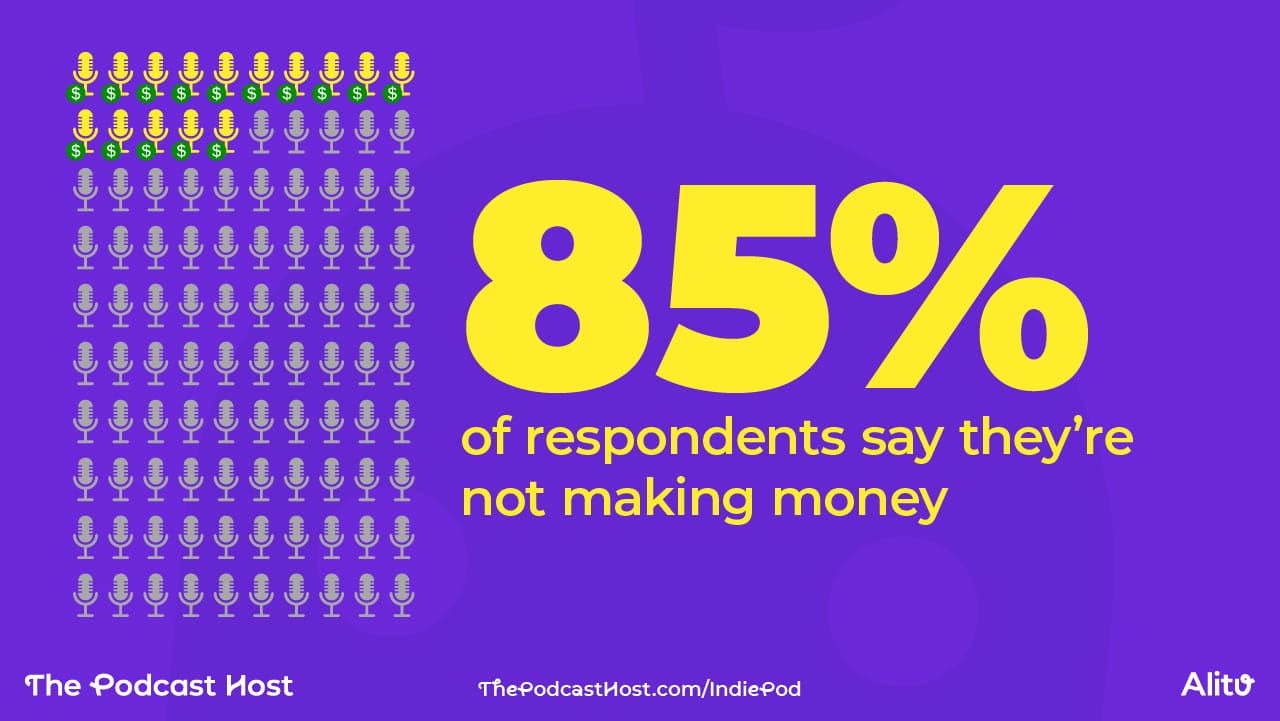
- 85% said no, their podcast doesn't make money
- 15% said yes, their podcast does make money
In other areas of the survey, only 9% of respondents considered revenue and profitability as their primary measure of success, and income wasn't among the top three 'ultimate goal' answers either. Therefore, the low "yes" numbers may be because the majority of participants don't see monetisation as a driver or priority just yet.
Of the monetising podcasters, we noticed a few trends:
- 29% were Interview podcasts
- 28% got 100-499 downloads per episode
- 46% had a weekly release schedule
- 32% were 40-59 minutes long
- 35% had been running for 3-5 years
- 33% cost $100 or more per month to run
This isn’t some sort of secret sauce for podcast monetisation, but it’s an interesting show of hands. The monthly cost is certainly an eye-opener, too. With 33% spending more than $100/month on their show, the drive to recoup costs likely ramps up when you see those bills on your bank statement every few weeks!
How would you describe the income you make?
Looking only at the folks who answered "yes" to the monetisation question (which obviously excludes our pre-launch pals, too), here’s a deeper look at what making money with their podcast looks like to them.
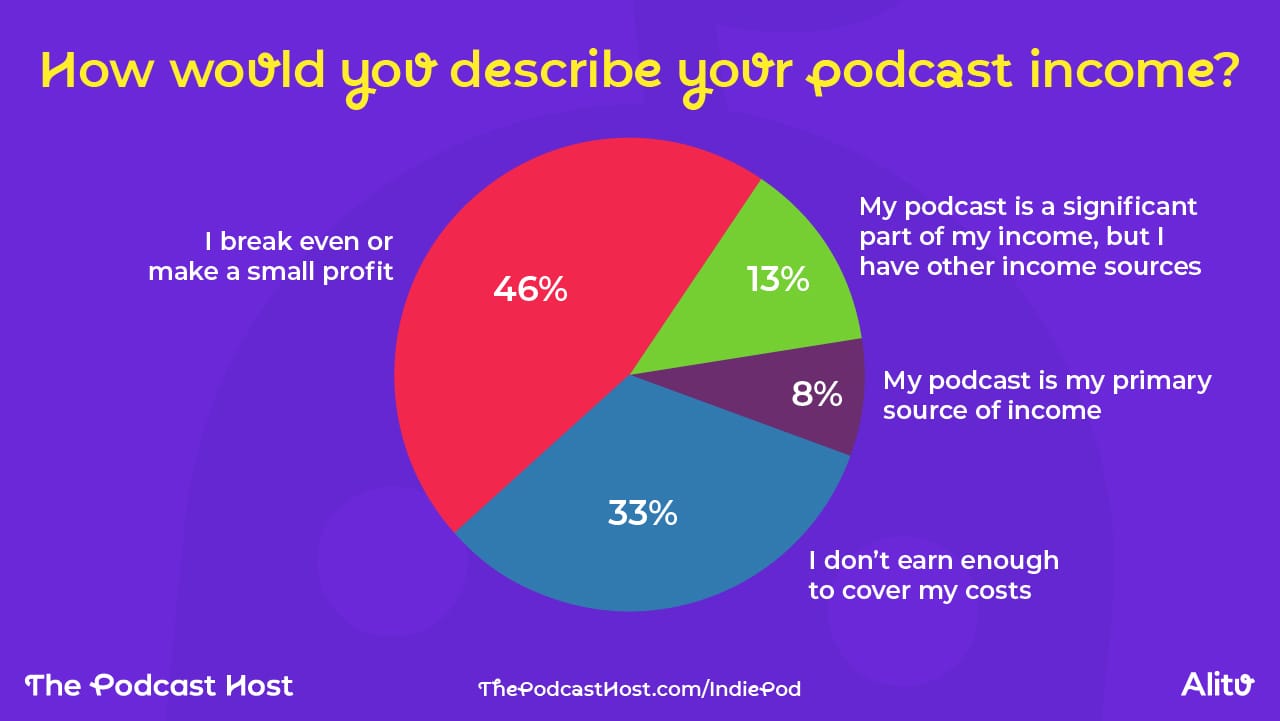
- I break even or make a small profit – 46%
- I don’t earn enough to cover my costs – 33%
- My podcast is a significant part of my income, but I have other income sources – 13%
- My podcast is my primary source of income – 8%
Next, we had a few follow-up questions for these folks.
Which of the following revenue streams have you used for your podcast?
Creating something someone likes so much that they’re willing to pay for it is no mean feat. So how are our indie podcasters doing it?
We presented them with a list of common monetisation methods and asked them to tick each one they’ve tried.
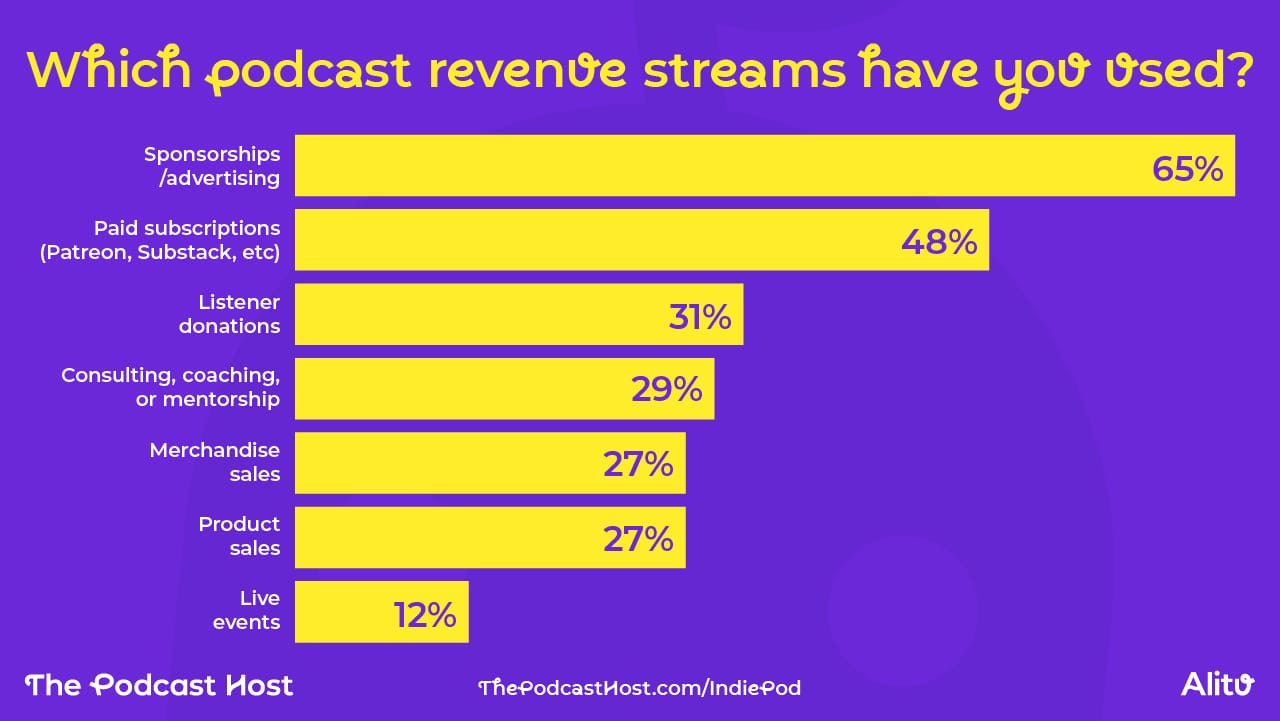
- Sponsorships/advertising – 65%
- Paid subscriptions (e.g., Patreon, Substack, Apple/Spotify subscriptions) – 48%
- Listener donations (e.g., crowdfunding, tips) – 31%
- Consulting, coaching, or mentorship – 29%
- Merchandise sales – 27%
- Product sales (e.g., books, courses, digital products)- 27%
- Live events – 12%
- Other – 6%
Sponsorship and advertising may be the "traditional" podcast monetisation method, but it definitely isn’t the most straightforward – nor the best fit for many shows. Still, 65% of monetising podcasters have managed to set up a deal of some sort, which is both surprising and encouraging.
Almost half of the monetising group have tried paid subscriptions like Patreon and Substack. Since these methods can be set up from day one (even if no one actually pays you), it's curious that this number isn't higher.
But of course, trying something and seeing results are two different things. Let's find out what's actually working for our respondents...
Which revenue stream has been the most profitable for you?
For this question, respondents could only pick one answer.
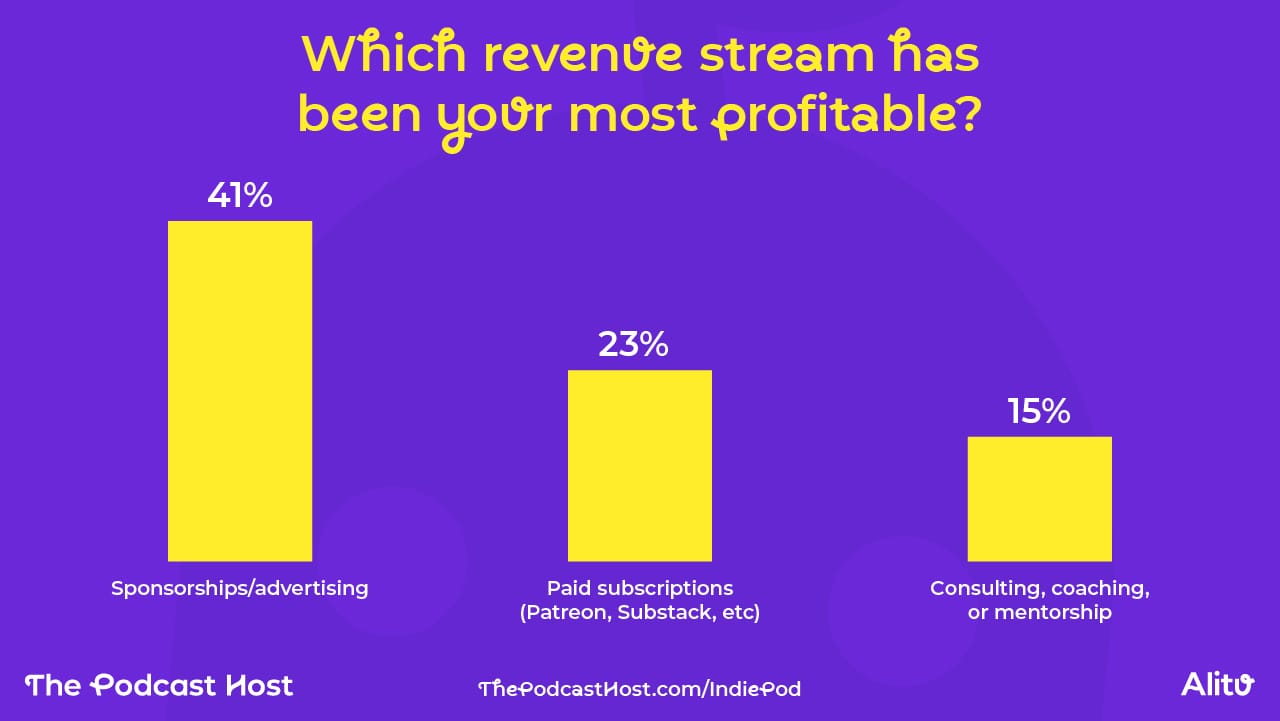
- Sponsorships/advertising – 41%
- Paid subscriptions (e.g., Patreon, Substack, Apple/Spotify subscriptions) – 23%
- Consulting, coaching, or mentorship – 15%
- Listener donations (e.g., crowdfunding, tips) – 5%
- Merchandise sales – 4%
- Product sales (e.g., books, courses, digital products)- 4%
- Live events – 3%
- Other – 5%
So podcast advertising is clearly working for many creators, with 41% of the monetising group saying this has been their most profitable revenue stream.
When people think of podcast sponsorship, they often picture generic ads for socks, food boxes, or mattresses that bring in pennies per episode. But does the data suggest that indie podcasters are striking more meaningful deals with sponsors who pay real money – not for reach, but for direct access to a small, niche group of ideal customers? Here's hoping!
Which revenue stream do you think has the most potential for podcasters in the next 12 months?
Then, we asked respondents to look ahead and tell us where they see the biggest monetisation opportunities for podcasters in the next year. Again, this was a “choose only one” response.
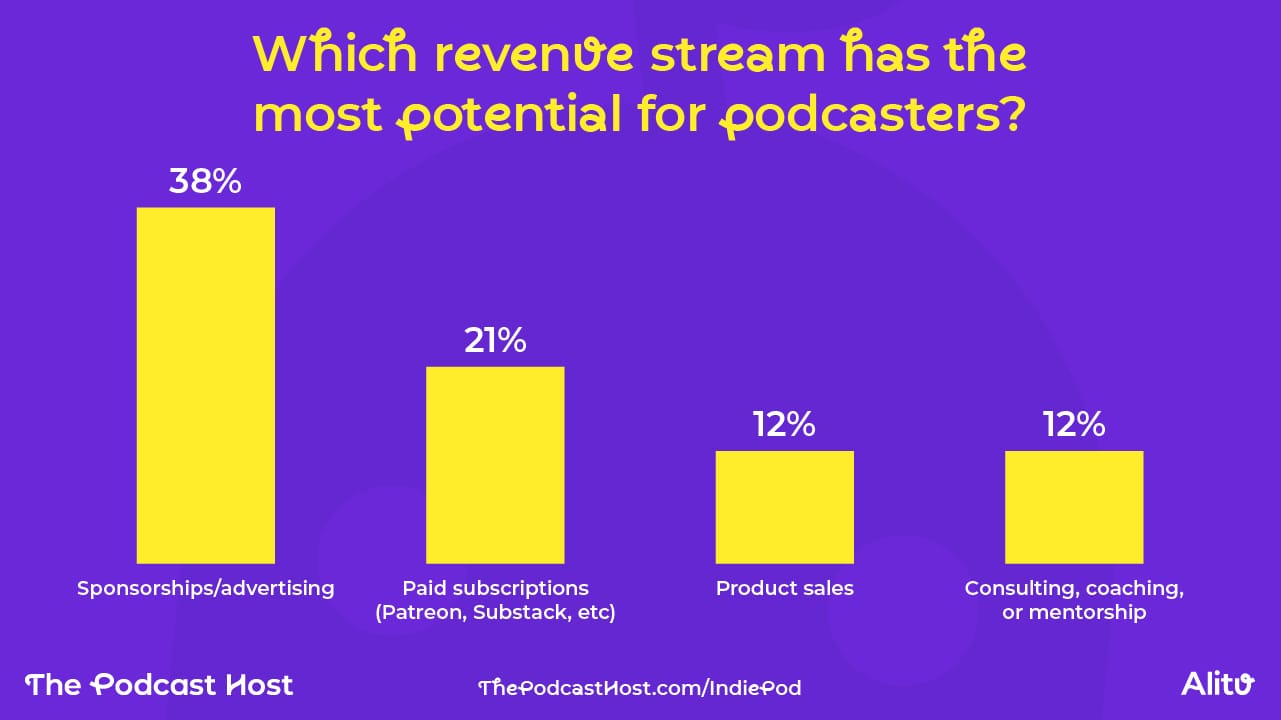
- Sponsorships/advertising – 38%
- Paid subscriptions (e.g., Patreon, Substack, Apple/Spotify subscriptions) – 21%
- Product sales (e.g., books, courses, digital products) – 12%
- Consulting, coaching, or mentorship – 12%
- Listener donations (e.g., crowdfunding, tips) – 7%
- Merchandise sales – 3%
- Live events – 3%
- Other – 4%
Unsurprisingly, with 41% of respondents achieving their best results through sponsorship and advertising, 38% believed it had the most potential for others as well.
Paid subscriptions and listener donations together didn’t reach 30%. That doesn’t mean these methods can’t work, but audiences may be tuning out of constant subscription requests. They’re simple to set up, but they take time and effort to generate any real income.
Do you publish a video version of your podcast?
Video! We couldn’t run a podcast survey without asking a question about whether podcasters are using video, could we?
There’s no doubt that demand for visuals in podcasting is growing, and many creators are doubling down on efforts to meet it. So what’s the lay of the land right now?
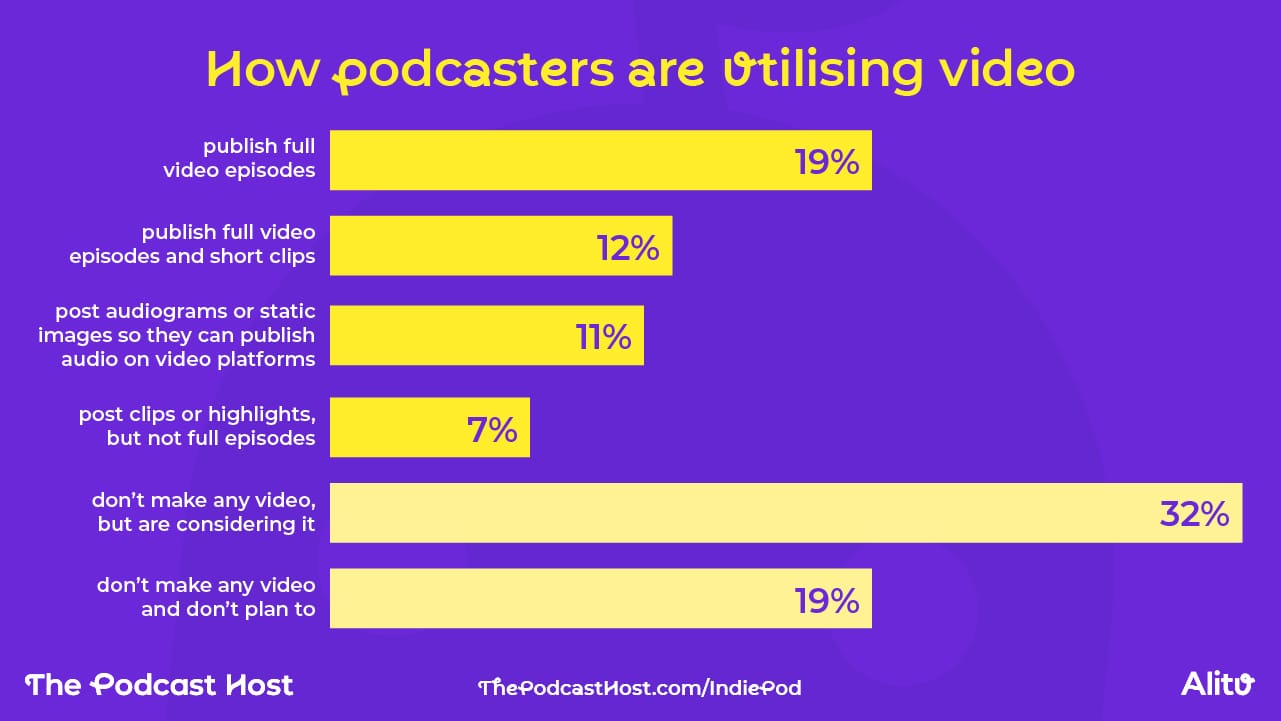
- 19% publish full video episodes
- 12% publish full video episodes and short clips
- 11% post audiograms or static images so they can publish audio on video platforms
- 7% post clips or highlights, but not full episodes
- 32% don’t make any video, but are considering it
- 19% don’t make any video and don’t plan to
This is data from the post-launch group only. Just under 40% are currently producing dynamic video of some sort, with almost one-third on the fence about adding a visual element.
When we dug into the data, we noticed that, of that 19% who don’t do video and have no plans to, 65% do everything by themselves. This was higher than the party-of-one folks doing full video (51%), full video with clips (44%), and short video (33%).
It's also worth mentioning that 43% of the full-episode video shows were interview podcasts, compared to 25% of the audio-only group. The majority format of the 'no video at all' camp was solo, at 36%, compared to 23% of video shows.
We'll have more insights on the relationship between video and audio in the 'time taken' and 'money spent' sections.
Are you using AI tools for any part of your podcast production?
If you had “video” on your podcast bingo card, you can check off “AI” now, too. Again, we have excluded pre-launcher data from these responses.
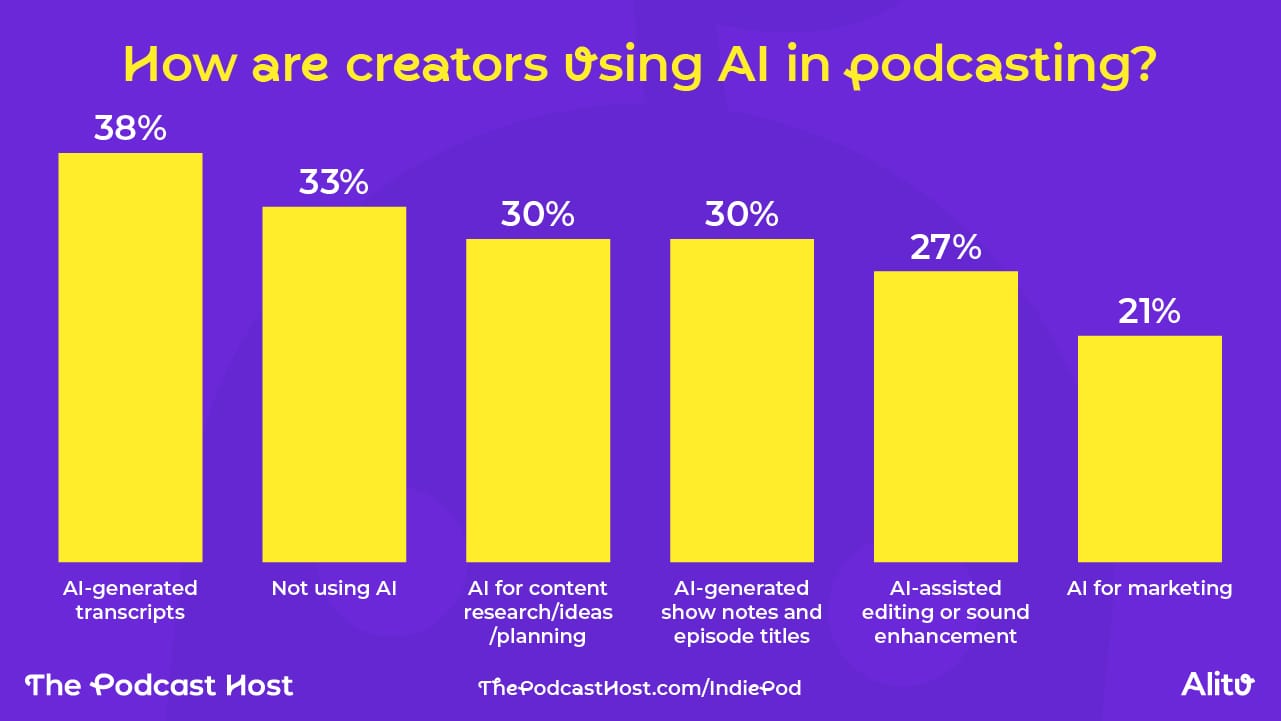
- AI-generated transcripts (e.g., Descript, Alitu, Otter.ai) 38%
- AI for content research/ideas/planning 30%
- AI-generated show notes and episode titles 30%
- AI-assisted editing or sound enhancement 27%
- AI for marketing (e.g., automated show notes, AI-generated clips) 21%
- I don’t use AI and don’t plan to 17%
- I’m not using AI, but I’d like to 16%
- AI voice cloning or synthetic hosts 3%
Overall, there were too many variables to draw any big conclusions from the data about how podcasters are using AI. But when we compared those who use AI assistants with those who do not, the average time to produce an episode was nearly the same.
It would be misleading to make the statement that "AI doesn't save you time in podcasting", but I think it's reasonable to say that it won't necessarily save you time. Any tool you add to your workflow can send you down rabbitholes you hadn't previously visited, even if that tool can do certain tasks much faster than you ever could!
AI & Video Editing
33% of video podcasters reported using AI-assisted editing tools, compared with 24% of their audio-only counterparts. While there is a growing range of AI tools for audio cleanup and production, far more platforms claim to turn full videos into viral clips. If you create video content, there is a good chance you have already experimented with one or two.
Which of the following best describes the format of your podcast?
Contrary to the mainstream media narrative, podcasts aren’t all “chat shows” with a new guest each episode. With that said, the interview is undoubtedly a major force in the medium.
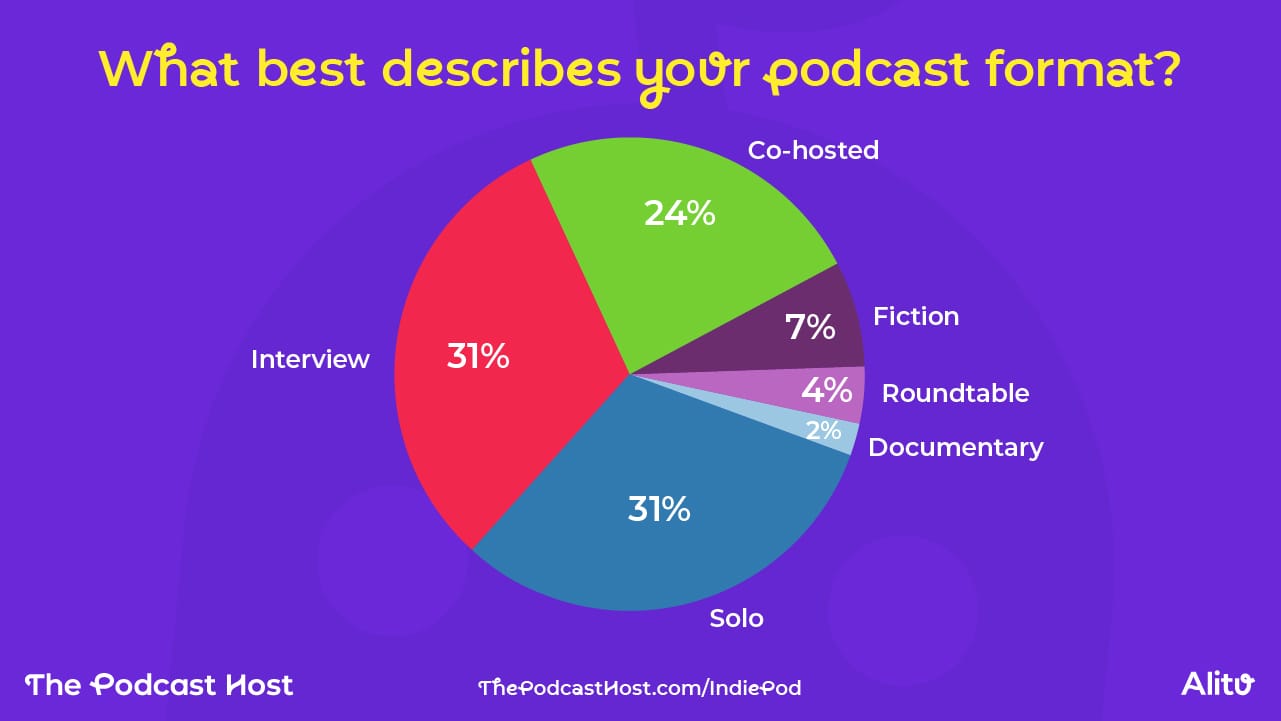
- Solo - 31%
- Interview - 31%
- Co-hosted - 24%
- Fiction - 7%
- Roundtable - 4%
- Documentary - 2%
Solo and interview shows are neck-and-neck for post-launch respondents, but when we look at pre-launch only, 53% said they plan to go solo, with 28% gearing up to run interview shows.
Back in 2022, our survey data indicated that 43% of new creators intended to go it alone, while 29% planned to do interviews. You could argue that, based on this year’s data, this hasn’t quite happened.
Anecdotally, a lot of podcasters start out on their own, but pivot to doing regular interviews soon after. Perhaps that’s exactly what we're seeing with this trend.
How many downloads do your new episodes typically get in the first week of their release?
This one excludes the pre-launch group, for very obvious reasons!
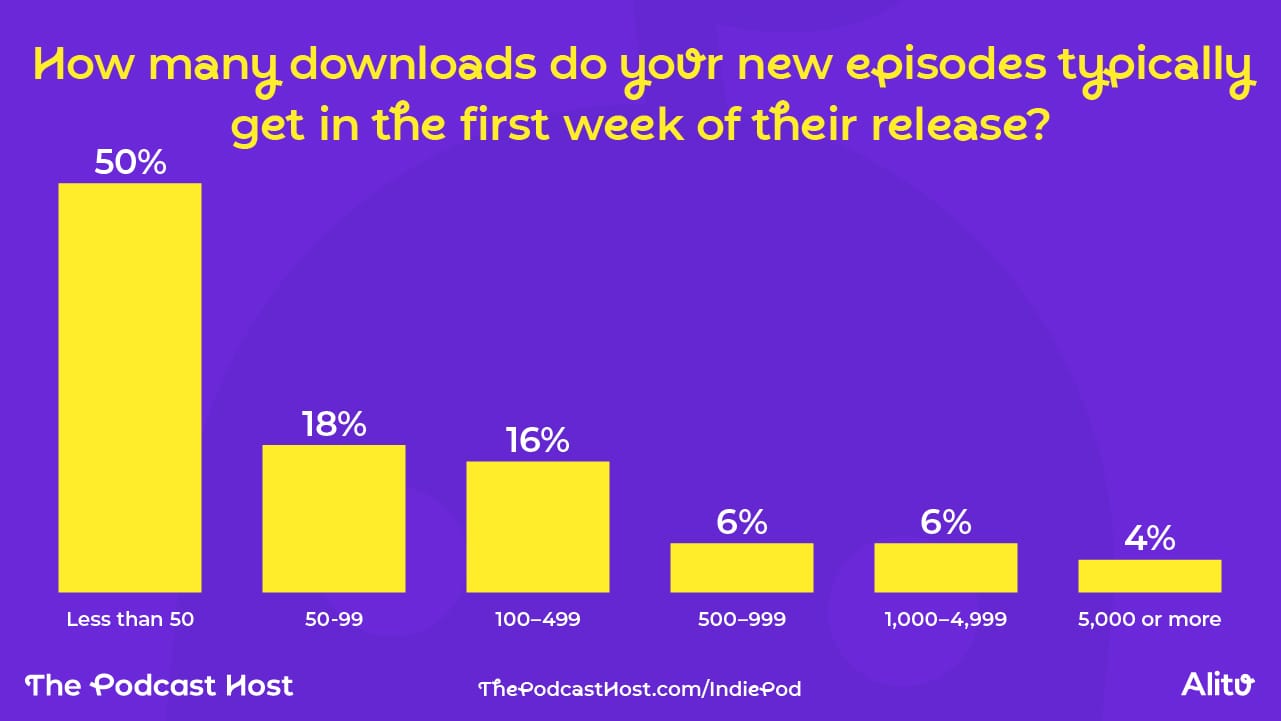
- Less than 50 – 50%
- 50-99 – 18%
- 100–499 – 16%
- 500–999 – 6%
- 1,000–4,999 – 6%
- 5,000 or more – 4%
According to some recent data from Buzzsprout (based on the 120k+ shows hosted on the platform), 28 downloads per new episode puts a podcast in the top 50%. This may seem like a low number, but there’s more to the story.
Of those who took part in our survey, almost half of those who get sub-50 downloads per episode have been podcasting for less than a year. But 22% have been going for 1-3 years, 16% for 3-5 years, 8% for 5-10 years, and 6% have been at it for over a decade. It just goes to show that it's not all about download numbers.
Saying that, we did spend some time digging deeper into what the 100+ download club are doing differently to see what we could learn.
How often do you typically release new episodes?
While there’s no “correct” podcast release schedule, those who publish weekly have always earned the quiet admiration of listeners and peers alike. Almost half of our post-launch respondents are managing to hit that weekly sweet spot.
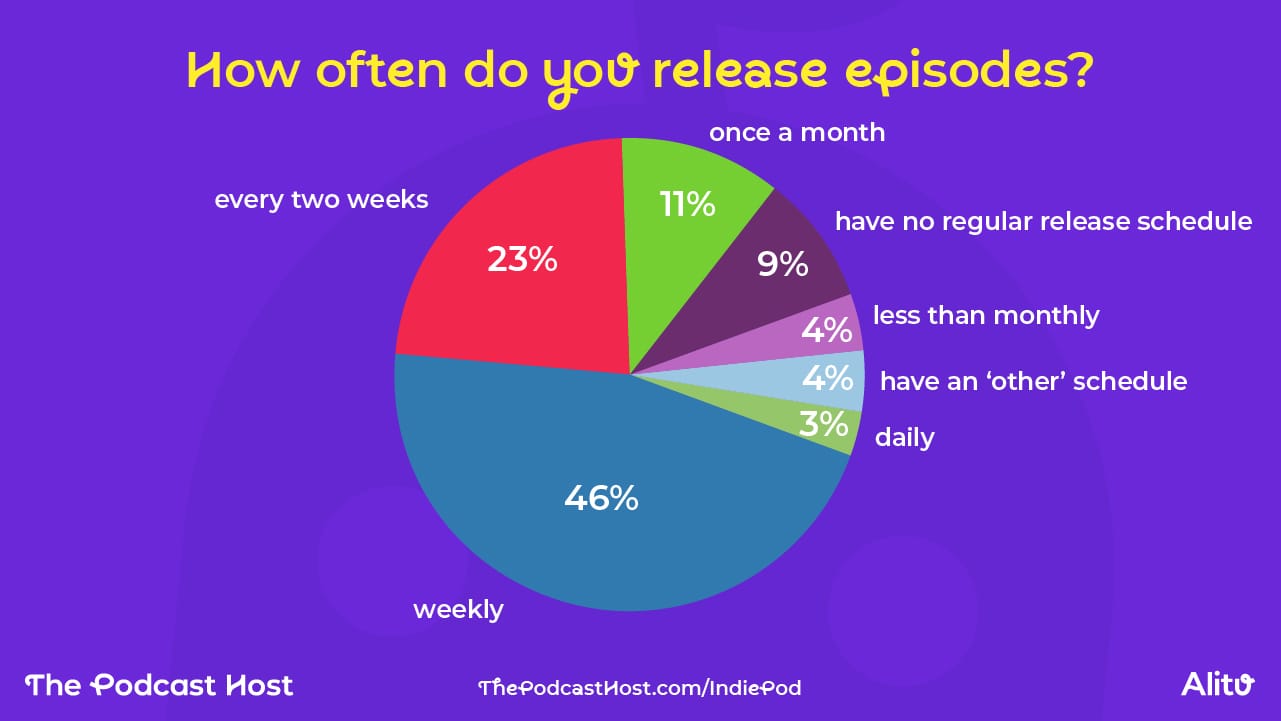
- 46% publish weekly
- 23% publish every two weeks
- 11% publish once a month
- 9% have no regular release schedule
- 4% publish less than monthly
- 4% have an ‘other’ schedule
- 3% publish daily
Every two weeks was also a popular release schedule, with almost a quarter of creators publishing on a fortnightly basis. This is a really underrated release schedule - a great blend of publishing regularly but not feeling like you're on a treadmill.
What’s your average podcast episode length?
Just like the question of “how often should you publish?”, there’s no optimal episode length, either. Again, taking out the pre-launch folks, here’s what we learned about average run times:
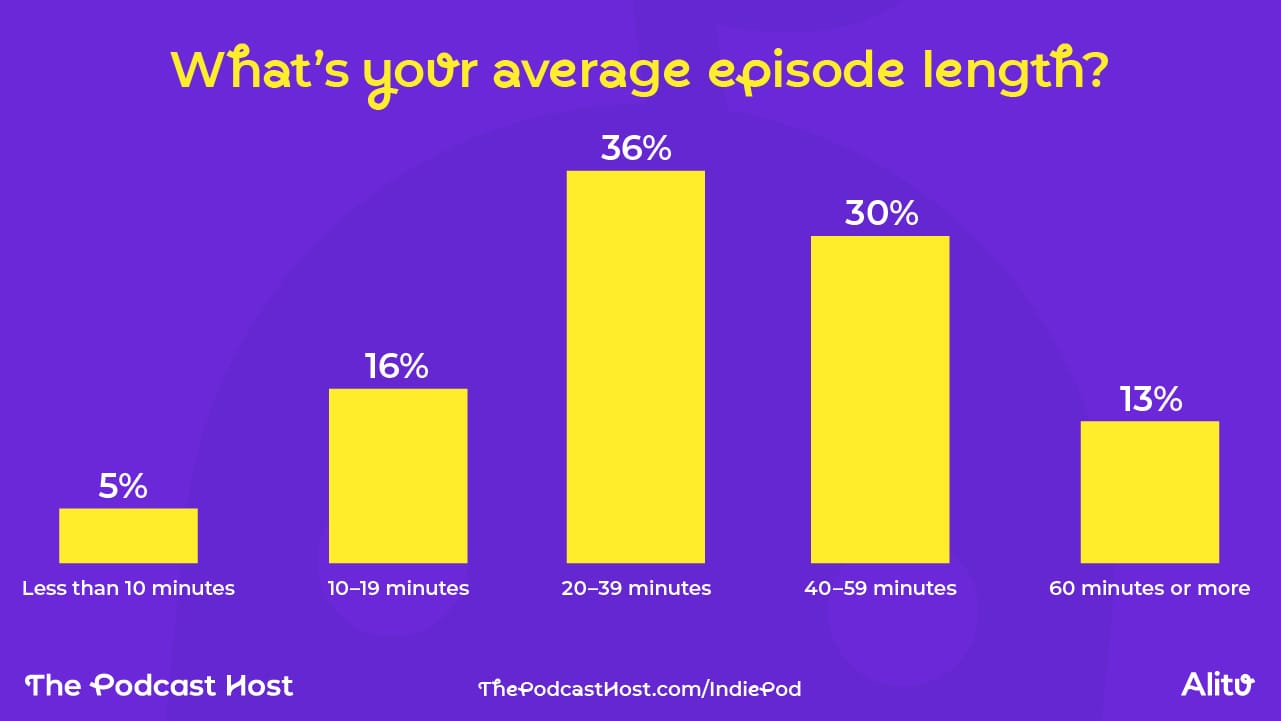
- Less than 10 minutes - 5%
- 10–19 minutes - 16%
- 20–39 minutes - 36%
- 40–59 minutes - 30%
- 60 minutes or more - 13%
It’s no surprise that most podcasts fall between 20 minutes and an hour – a pattern echoed in reports from the big hosting companies. And because only a few respondents run daily shows, this likely led to only a few creators reporting sub-10-minute episodes, too.
The key takeaway here? A podcast episode should be as long as it needs to be. The only length worth avoiding is one that doesn't fit what you have to say.
How many hours do you spend making a single episode, from planning right through to publishing?
How long it takes to make a podcast isn’t as easy to work out as looking through release schedules and episode lengths. Again, for this question, we focused purely on the post-launch group.
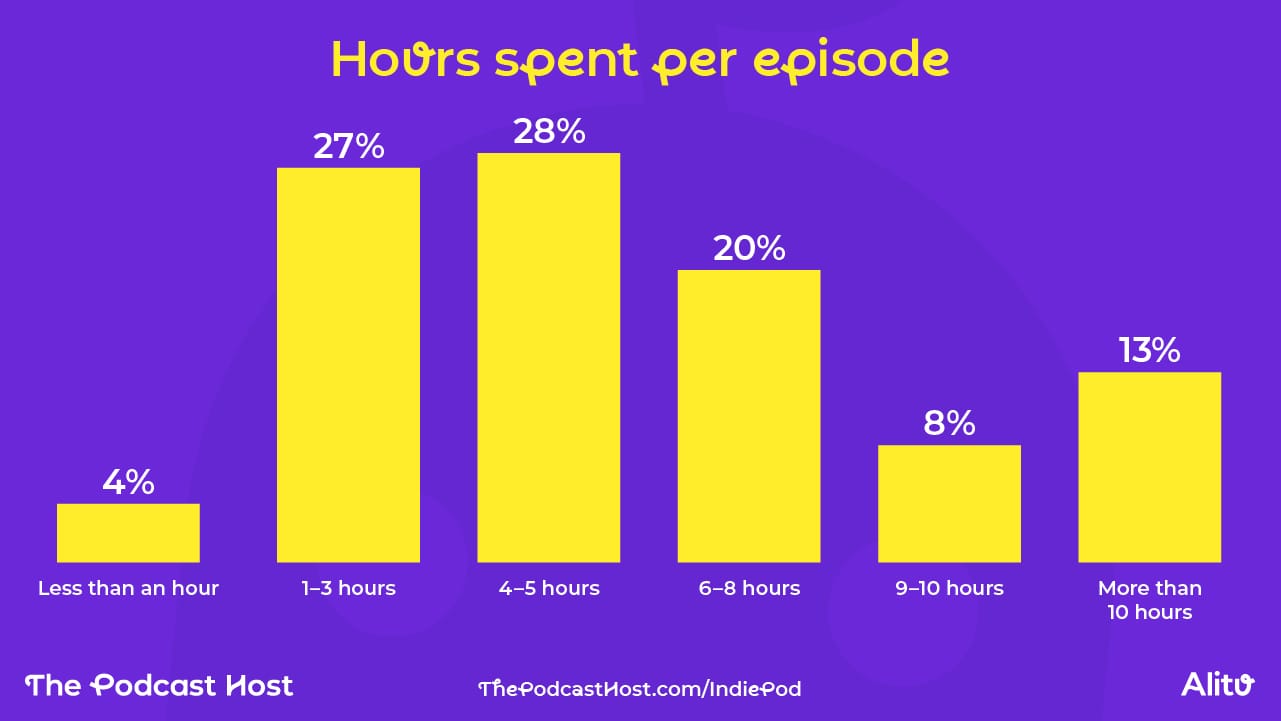
- Less than an hour – 4%
- 1–3 hours – 27%
- 4–5 hours – 28%
- 6–8 hours – 20%
- 9–10 hours – 8%
- More than 10 hours – 13%
Video Vs Audio Production Time
Video and audio-only podcasters spend a similar amount of time creating each episode, with most in both groups falling into the 1-3 or 4-5 hour ranges from planning to publishing.
However, the survey suggests audio-only creators are more likely to invest longer overall, with around 45% spending more than six hours per episode compared to about 36% of video podcasters.
At first glance, it may seem surprising that video podcasts can take less time to produce than audio-only shows. But audio creators often follow a more traditional editing culture, spending extra time refining sound quality and shaping the story, while many newer video chat-style podcasts favour a quick, minimal-production approach.
Ultimately, the difference isn’t about video versus audio; it’s about the mindset behind the edit.
How much does it cost per month to run your podcast?
We’ve talked about income, but what about expenses? How much does this podcasting malarky actually cost creators? This is data from the post-launch group only.
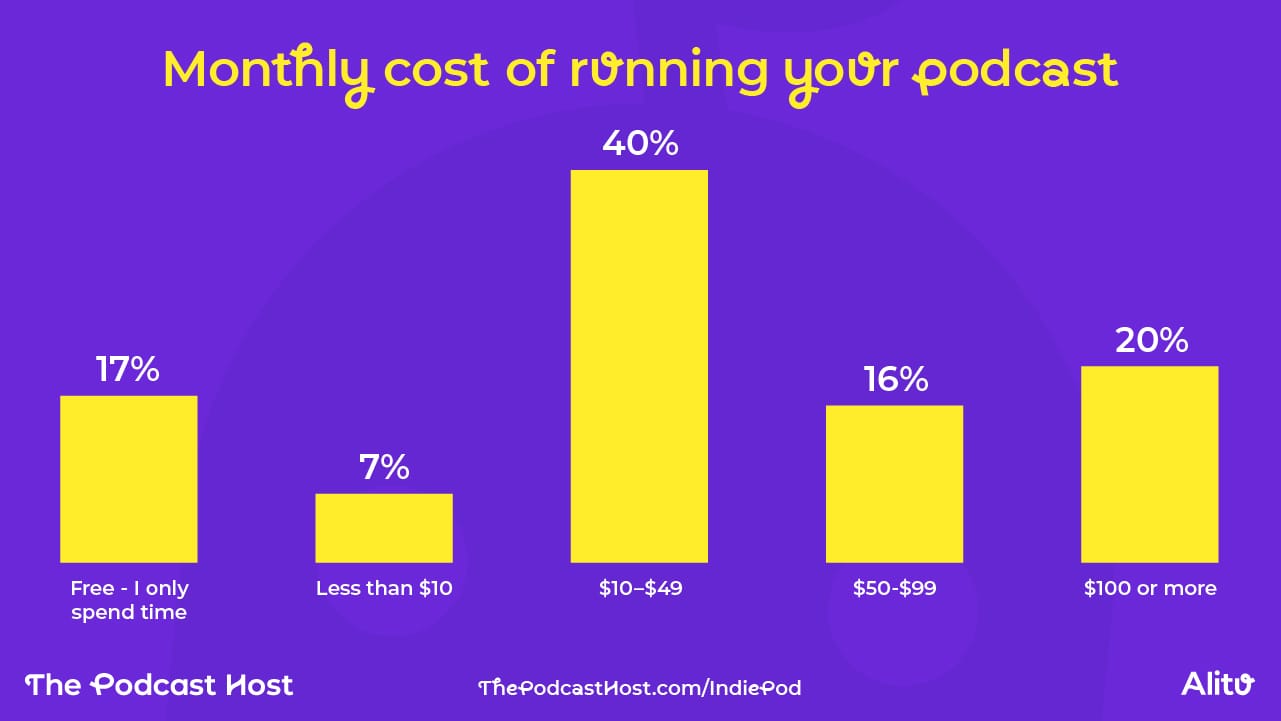
- Free – I only spend time! – 17%
- Less than $10 – 7%
- $10–$49 – 40%
- $50-$99 – 16%
- $100 or more – 20%
Video Vs Audio Costs
The data shows a clear difference in spending patterns between full video and audio-only podcasters. Video podcasters tend to spend more, with half of this group investing $50 or more each month, compared to just 28% of audio-only podcasters.
47% of audio-only podcasters report spending $10–$49, compared to 28% of video podcasters in this mid-range expense bracket.
So if you add video, you might not necessarily add more hours to your workflow, but it is likely to cost you more.
Free Vs $100+ Podcasters
Running a podcast for free and spending over $100/month are the two extreme ends of the scale. So are there any notable differences between shows running with and without a budget?
Free
- 29% produce full video episodes and clips
- 53% are solo shows
- 40% release weekly
- 31% spend 1-3 hours per episode
- 65% do all the work themselves
- 68% get less than 50 downloads per episode
- 13% get between 50-99 downloads per episode
- 11% get between 100-499 downloads per episode
$100+
- 46% produce full video episodes and clips
- 47% are interview shows
- 50% release weekly
- 27% spend 4-5 hours per episode
- 25% do all the work themselves (56% hire an editor)
- 24% get less than 50 downloads per episode
- 18% get between 50-99 downloads per episode
- 20% get between 100-499 downloads per episode
Respondents who invest over $100 a month seem far less likely to stay stuck under 50 downloads and much more likely to grow into higher audience tiers compared to those spending nothing.
The data also suggests that creators producing their shows for free are more likely to make audio-only solo podcasts, while interview and video formats are more common among those spending more than $100 per month.
We dug further into the data to find out if those respondents are managing to run a successful podcast on no budget. Here's what we learned.
Podcasters spending more than $1,000 a year on their shows likely often approach them as businesses. Many hire editors (56%), but time savings are not always their main concern. Only 14% of them cited "lack of time" as a reason they've considered quitting.
For this group, the leading goal is to turn podcasting into a primary income source (22%). Yet more than half say making money is their biggest challenge (54%), and nearly two-thirds report earning nothing at all (62%). Unsurprisingly, the top reason these creators consider quitting is financial strain or an inability to monetise (37%).
Who else is involved in making your podcast?
So we know that 56% of the $100+ group hire an editor, producer, or audio engineer to get their podcast over the line. Now, let’s look at some other ways our post-launch respondents are getting help to make their shows.
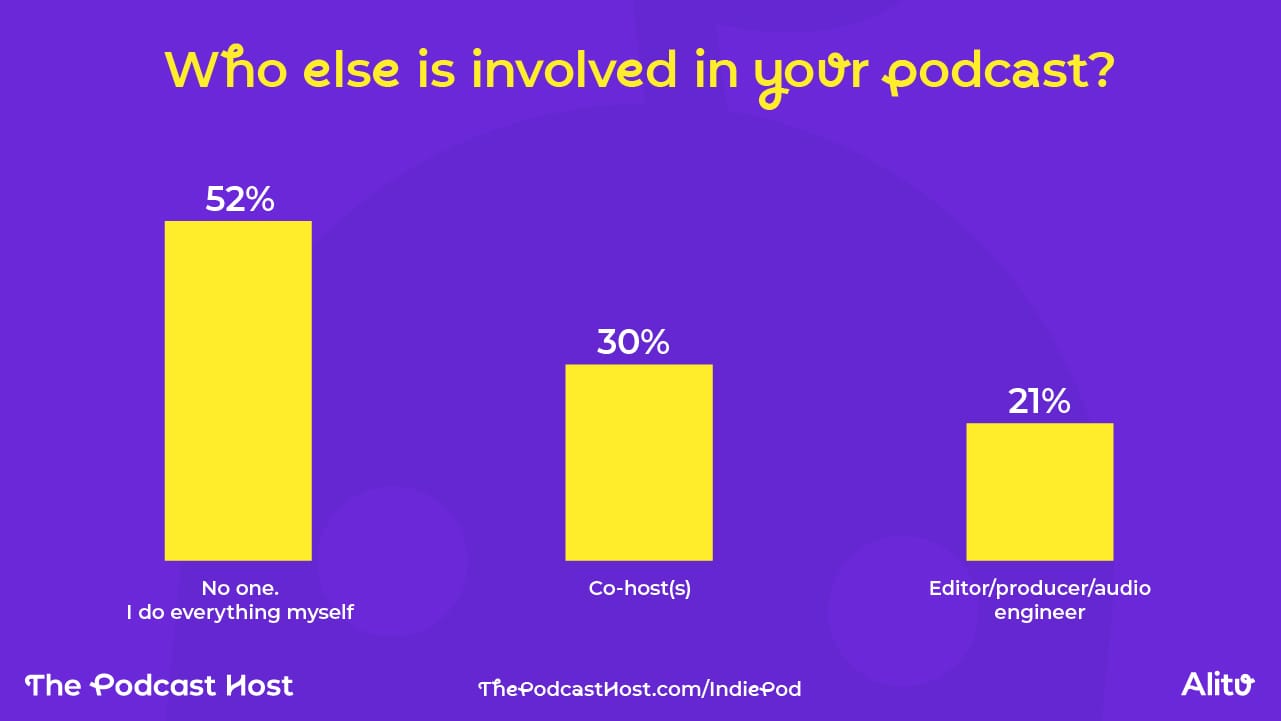
Participants were allowed to choose more than one option for this question. Over half told us they run their show fully DIY. Co-hosts were the most common form of help, followed by editors and audio producers.
- No one. I do everything myself – 52%
- Co-host(s) – 30%
- Editor/producer/audio engineer – 21%
- Social media or marketing support – 8%
- Admin assistant/PA/virtual assistant – 7%
- Graphic designer or visual content creator – 6%
- Web or tech support – 5%
- Scriptwriter or show writer – 4%
- Researcher or fact-checker – 2%
- Guest booker/talent coordinator – 2%
- Community manager – 2%
- Other – 5%
Two correlations stood out here:
- 16% of male respondents hired an editor, but that rose to 28% in the female group.
- 28% of video podcasters reported hiring an editor compared to 15% in the audio-only camp.
Of the folks who have some sort of help in making their shows, 22% make money from them, 36% spend $10-$49 per month on podcasting, and 31% spend more than $100.
If you’ve ever considered quitting podcasting, what were the main reasons?
Again, we've omitted our pre-launch group from this question for obvious reasons.
Of those we surveyed, 41% of respondents said they've never considered quitting. However, audience growth, lack of time, finances, and burnout are all common issues facing indie podcasters.
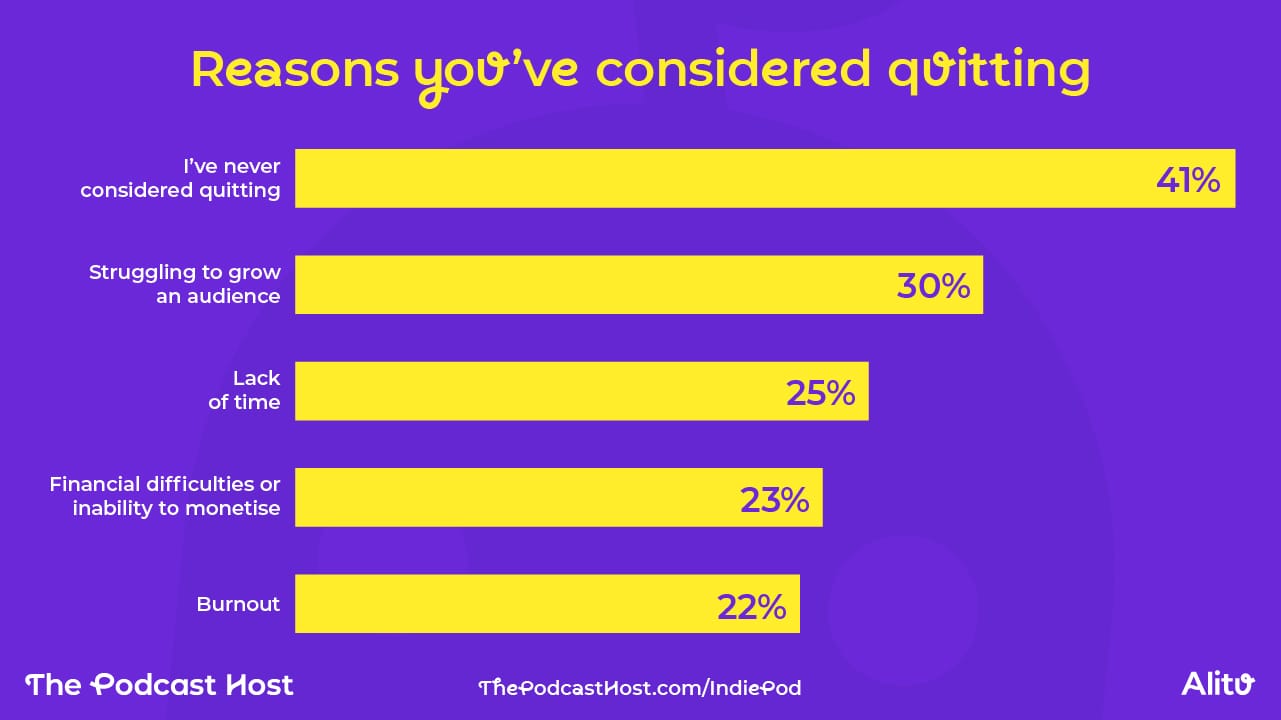
- I’ve never considered quitting – 41%
- Struggling to grow an audience – 30%
- Lack of time – 25%
- Financial difficulties or inability to monetise – 23%
- Burnout – 22%
- Loss of motivation or inspiration – 16%
- Technical challenges or lack of resources – 10%
- Inadequate platform support – 3%
- Other – 3%
When we dove deeper into the respondent demographics of those who answered this question, we noticed that 51% of the over-50s have never considered quitting, compared to just 32% of the under-50s.
46% of men have never considered quitting, compared to 34% of women. 34% of women also cited struggles with audience growth as a reason for considering stopping. 27% of men felt the same way.
Female respondents were also more likely to experience burnout. 28% of women reported this as a reason for considering quitting, compared to 17% of men.
How do you primarily measure success with your podcast?
Definitions of success in podcasting vary. Audience size is the most common indicator to creators (46%), but creative fulfilment is more important to 21%, and engagement is a comfortable third at 18%.

- Audience size & growth – 46%
- Creative fulfilment – 21%
- Listener engagement (active community, social media interaction, reviews) – 18%
- Revenue & profitability – 9%
- Industry recognition (Awards, media coverage, rankings) – 2%
- Breaking into bigger media opportunities (TV, book deals, etc.) – 2%
- Other – 2%
Pre-Launch Podcaster Success Measurements
There were some subtle deviations in perceptions of how to measure success in the yet-to-launch camp.
- 43% say audience size and growth
- 23% say listener engagement
- 15% say creative fulfilment
The differences are small, but they hint at a mindset shift: pre-launch podcasters tend to prioritise community engagement, while experienced podcasters may discover that creative fulfilment plays a bigger role in sustaining the work longer-term.
Do you feel like you’re achieving your goals in podcasting?
Looking again at our post-launch group, here’s how they feel they are doing when it comes to achieving their goals and realising their podcast ambitions.
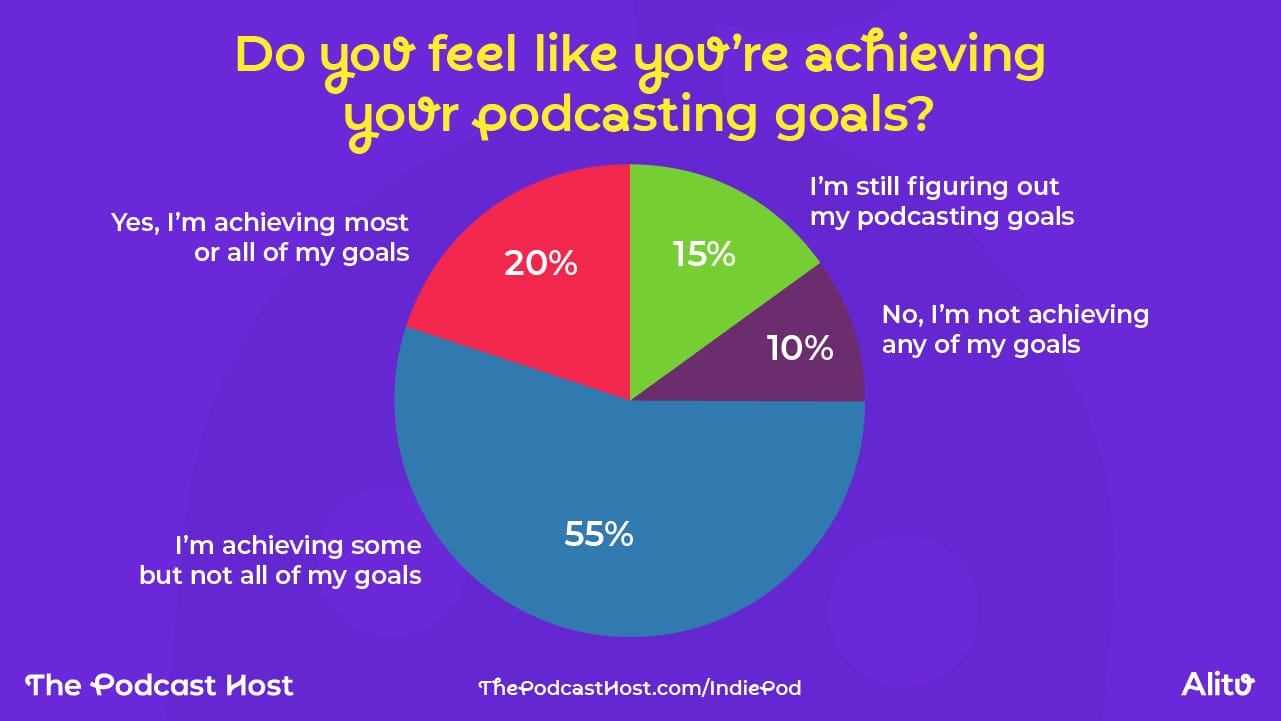
- Yes, I’m achieving most or all of my goals – 20%
- I’m achieving some but not all of my goals – 55%
- No, I’m not achieving any of my goals – 10%
- I’m still figuring out my podcasting goals – 15%
Of the 20% who feel like they’re achieving most or all of their goals, it’s interesting to note that personal enjoyment and creative fulfilment (30%) are pretty much just as important to them as helping, supporting, or motivating others (31%).
We also see that creative fulfilment (33%) is just as important to them when it comes to measuring success as audience size and growth (34%).
In contrast, creative fulfilment was less of a driver amongst the "some but not all" camp. 19% of them reported this as their ultimate goal, behind "help, support, or motivate" at 27%.
Of those who said they're not achieving their podcast goals, 58% see audience size and growth as their primary measure of success. 42% see their primary goal as helping, supporting, or motivating others, and 73% see growing an audience and discoverability as their biggest challenges.
71% of those who don't feel like they're achieving their goals get fewer than 50 downloads per episode.
What is the biggest threat podcasters face in the next 3 years?
This is data from all respondents, both pre- and post-launch.
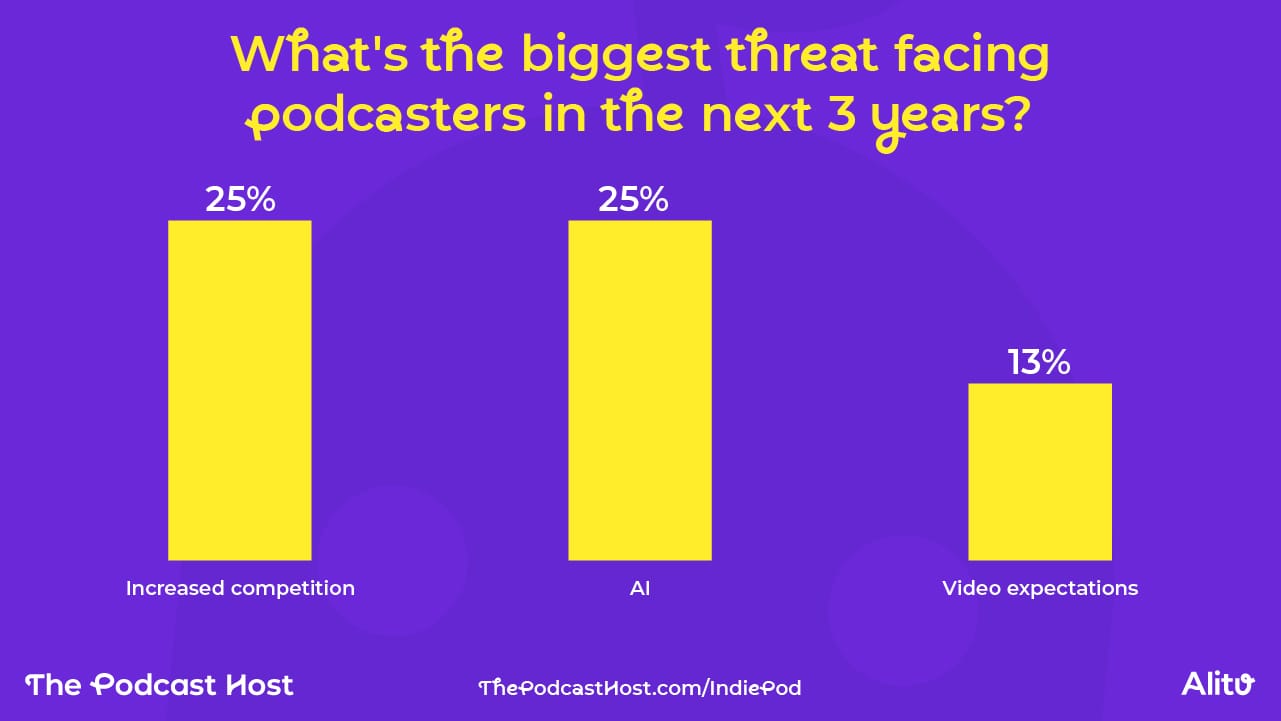
- Increased competition 25%
- AI 25%
- Adapting to video podcast expectations 13%
- Changing listener habits 8%
- Platform fragmentation and “walled garden” content 7%
- Declining interest in spoken-word audio 7%
- Growing production costs/demands 6%
- Declining advertising rates 4%
- Other 5%
One minor but noticeable trend here was that 28% of the under-50s see AI as the biggest threat, whilst increased competition was seen as the biggest threat by the over-50s (26%).
Many of the AI-threat group still reported using AI tools, with AI-generated transcripts the most common use case at 29%. AI for content research, ideas and planning came in second among this group, at 24%. 20% said they weren't using AI, but would like to. 29% had no plans to use it at all.
Of the 13% who were worried about adapting to video expectations, 37% don't currently do video but are thinking about it, while 15% aren't and don't plan to.
Pre-launch Indies
As we highlighted, 19% of survey respondents hadn't yet launched a podcast, so their answers were excluded from much of this report.
Still, we wanted to capture the aims and ideas of aspiring creators, too. In this section, we set aside the post-launch group to learn more about the next generation of podcasters. Here's what we learned.
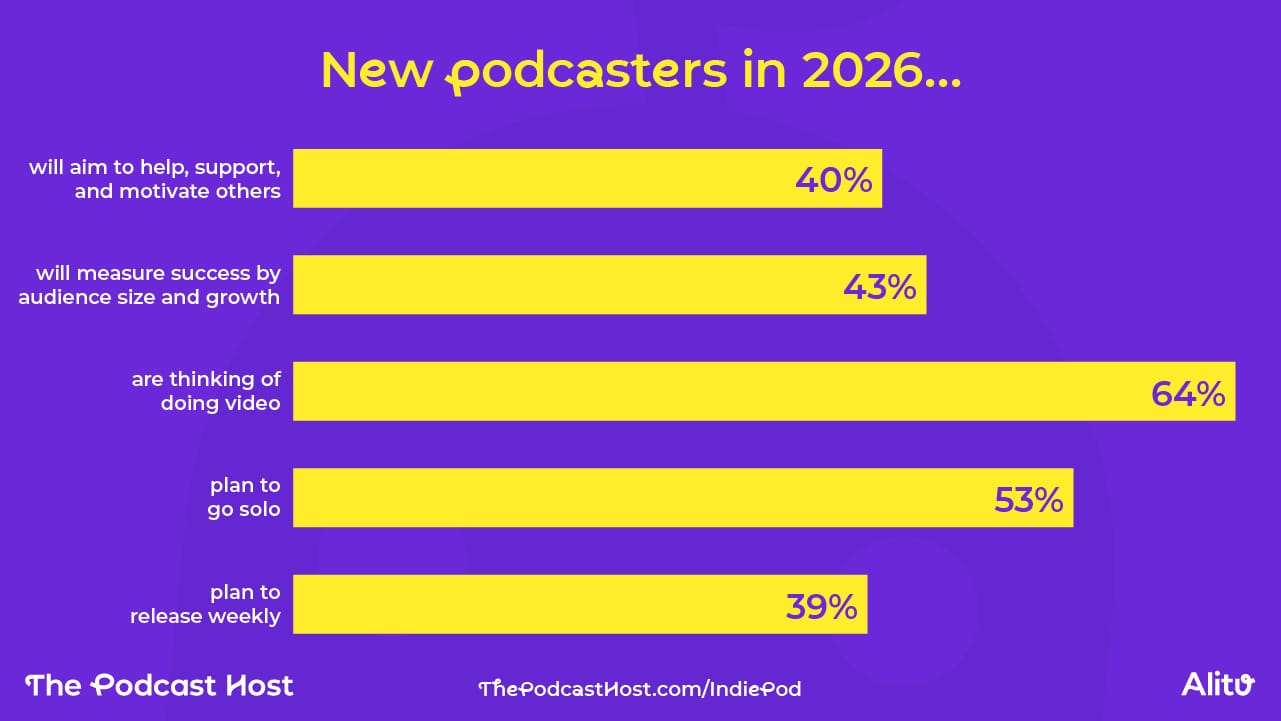
- 40% will aim to help, support, and motivate others
- 43% will measure success by audience size and growth
- 34% see sponsorship and advertising as having the most monetisation potential
- 64% are considering publishing video
- 36% are considering using AI
- 53% plan to run solo episodes
- 39% plan to release weekly
- 71% plan to do all the work themselves
- 57% are female vs 33% male
- 52% are over the age of 50
While the broad motivations of pre- and post-launch podcasters look similar, the contrasts show a clear shift from ambition to pragmatism. Pre-launchers hope to grow big audiences, land sponsors, and manage solo weekly shows (often with video).
In reality, we've learned from active podcasters that creative fulfilment is just as vital as audience numbers. Consistency is the ultimate driver of podcast success, and if you don't enjoy it, you'll never stick with it.
Alright, time for one of those "what did we learn?" scenes, like at the end of Thundercats episodes, where they all sit around the Cat's Lair and discuss what beating Mumm-Ra (again) taught them...
5 Big Takeaways
Finally, an H2 heading I can repurpose on my fast food blog. 20-odd graphics and nearly 5000 words later, what have we learned from our 2025 Indie Podcaster Survey?
You have the data to draw your own conclusions, but here are some of our top-level insights (and you'll find deeper-dive articles into the data over on Podcraft Perspectives).
#1 Indie podcasters prioritise passion over profit
The vast majority of respondents don’t make money from their shows, and many aren’t trying to. Instead, their top goals are to help others, share knowledge, and simply enjoy the creative process.
#2 Growth is the hardest game
Discoverability and audience growth remain the number one hurdle for creators of all sizes. This struggle is especially discouraging for younger and female respondents, who are more likely to feel burnout or think about quitting.
#3 The sponsorship surprise
Among those who do earn income from their podcast, sponsorship and advertising are still the most effective and profitable methods. While subscriptions and donations attract plenty of hype, they lag far behind in results, suggesting niche sponsorship deals are quietly powering indie monetisation.
#4 AI doesn't guarantee time saved
There was no clear difference in time spent between podcasters using AI and those who don't. Even so, there are many variables at play, so it's difficult to draw firm conclusions. This will be an important trend to revisit in next year’s survey.
#5 Video doesn't necessarily add time, but it might add cost
Video and audio-only podcasters reported similar timeframes for creating episodes, though audio-only creators were more likely to spend six hours or more on each one. Video podcasters, meanwhile, reported higher monthly costs, partly due to the added expense of software and a greater tendency to hire editors.
5 Action Steps For Indies
And finally, what does this all mean for you as a creator? What can we learn from these results, and put into practice in our day-to-day podcasting workflows?
#1 Build community, not just numbers
Discoverability is tough, so focus on strengthening ties with your current listeners. Encourage reviews, create interactive spaces like Discord or Circle groups, and think of growth as deepening engagement rather than solely chasing reach. On top of that, put a big onus on collaboration with other content creators in your niche. Community and collaboration are integral parts of our SCALE podcast growth framework. Even if you did nothing else to market your show, you'd still see results, here.
#2 Explore niche sponsorships early
Even small shows can attract valuable sponsors if they serve a clear niche. You don’t need to wait until you hit thousands of downloads. Start conversations with relevant businesses, professional groups, or brands that align with your audience.
#3 Protect your creative energy
Burnout is common, especially amongst younger podcasters. Try a bi-weekly release, shorter episodes, or seasonal runs to keep the show sustainable. Long-term consistency matters more than overcommitting.
#4 Be prepared to spend on video
If you choose to add video, expect your monthly costs to rise. You can simply turn on your webcam and upload raw Zoom recordings, but creating something your audience will actually watch instead of their favourite Netflix shows usually takes extra investment in gear, software, and production support.
#5 Use tools strategically and deliberately
Plenty of AI and podcasting tools claim to save time, but nothing can guarantee it. It isn’t your job to make room in your workflow for every new tool, no matter how promising it sounds. Keep your toolkit as small as possible and make sure everything you use earns its place.
And with that all said, if you’re spending six hours or more producing each episode, there’s a good chance Alitu can help 😉
The Independent Podcaster Report 2025
We're delighted to be able to present this data to you, and hope that you've found it insightful and encouraging. A huge thanks to everyone who took the time to share and fill out the survey, too, and to Lewitt for putting up some pro-level gear for our prize draw. We couldn't have done this without you all 😊
There are many more stories to explore from this data, and that's exactly what we'll be doing in the coming months. If you want our latest reports and analysis delivered to you the minute they're published, be sure to sign up to the Podcraft Perspectives newsletter.
And finally, if you decide to cover this report on your own podcast, site, or channels, be sure to let us know so we can share it out!
